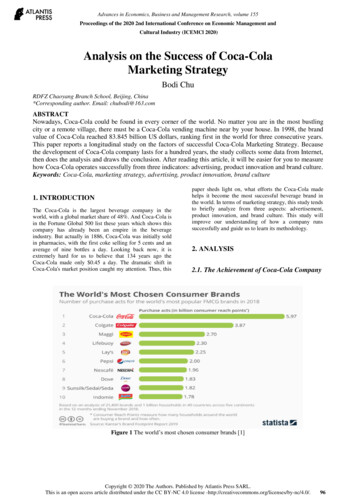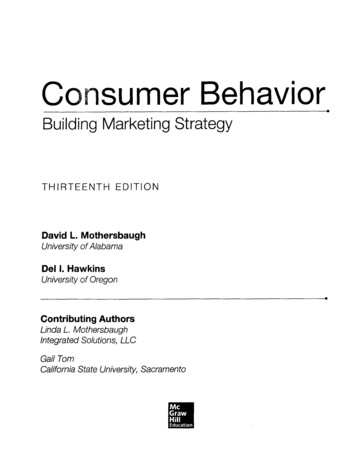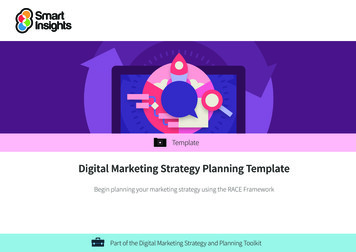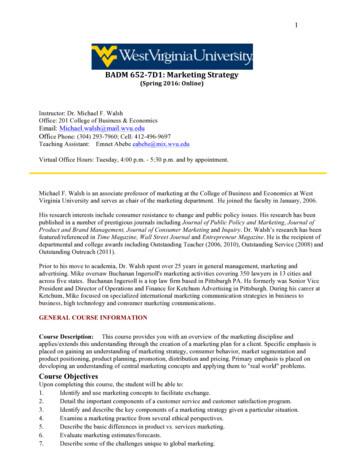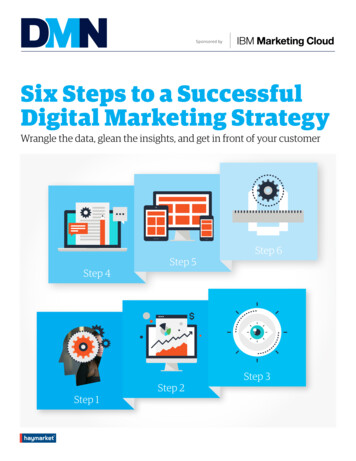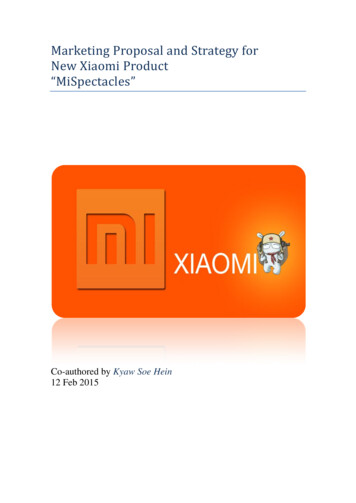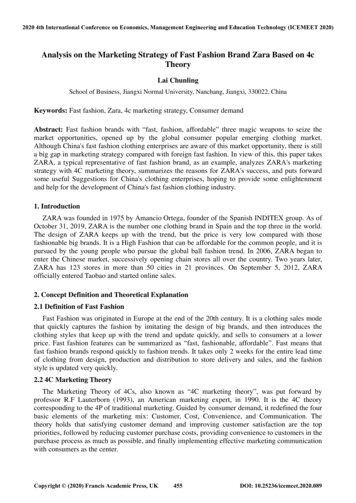
Transcription
2020 4th International Conference on Economics, Management Engineering and Education Technology (ICEMEET 2020)Analysis on the Marketing Strategy of Fast Fashion Brand Zara Based on 4cTheoryLai ChunlingSchool of Business, Jiangxi Normal University, Nanchang, Jiangxi, 330022, ChinaKeywords: Fast fashion, Zara, 4c marketing strategy, Consumer demandAbstract: Fast fashion brands with “fast, fashion, affordable” three magic weapons to seize themarket opportunities, opened up by the global consumer popular emerging clothing market.Although China's fast fashion clothing enterprises are aware of this market opportunity, there is stilla big gap in marketing strategy compared with foreign fast fashion. In view of this, this paper takesZARA, a typical representative of fast fashion brand, as an example, analyzes ZARA's marketingstrategy with 4C marketing theory, summarizes the reasons for ZARA's success, and puts forwardsome useful Suggestions for China's clothing enterprises, hoping to provide some enlightenmentand help for the development of China's fast fashion clothing industry.1. IntroductionZARA was founded in 1975 by Amancio Ortega, founder of the Spanish INDITEX group. As ofOctober 31, 2019, ZARA is the number one clothing brand in Spain and the top three in the world.The design of ZARA keeps up with the trend, but the price is very low compared with thosefashionable big brands. It is a High Fashion that can be affordable for the common people, and it ispursued by the young people who pursue the global ball fashion trend. In 2006, ZARA began toenter the Chinese market, successively opening chain stores all over the country. Two years later,ZARA has 123 stores in more than 50 cities in 21 provinces. On September 5, 2012, ZARAofficially entered Taobao and started online sales.2. Concept Definition and Theoretical Explanation2.1 Definition of Fast FashionFast Fashion was originated in Europe at the end of the 20th century. It is a clothing sales modethat quickly captures the fashion by imitating the design of big brands, and then introduces theclothing styles that keep up with the trend and update quickly, and sells to consumers at a lowerprice. Fast fashion features can be summarized as “fast, fashionable, affordable”. Fast means thatfast fashion brands respond quickly to fashion trends. It takes only 2 weeks for the entire lead timeof clothing from design, production and distribution to store delivery and sales, and the fashionstyle is updated very quickly.2.2 4C Marketing TheoryThe Marketing Theory of 4Cs, also known as “4C marketing theory”, was put forward byprofessor R.F Lauterborn (1993), an American marketing expert, in 1990. It is the 4C theorycorresponding to the 4P of traditional marketing. Guided by consumer demand, it redefined the fourbasic elements of the marketing mix: Customer, Cost, Convenience, and Communication. Thetheory holds that satisfying customer demand and improving customer satisfaction are the toppriorities, followed by reducing customer purchase costs, providing convenience to customers in thepurchase process as much as possible, and finally implementing effective marketing communicationwith consumers as the center.Copyright (2020) Francis Academic Press, UK455DOI: 10.25236/icemeet.2020.089
3. Marketing Strategy Analysis of Zara in Theory 4c3.1 Meet Customer Needs3.1.1 Imitate the Big Brands and Follow the Fashion TrendIn order to meet the target customers' pursuit of fashion trends, ZARA chooses to imitate thedesign of international brands in clothing design. At the same time, we will learn the preference ofconsumers according to the feedback information and sales data of customers, and then improve theproducts. This strategy allows ZARA to quickly design and produce clothing that meets the needs ofconsumers to keep up with fashion trends by quickly following the fashion trends of major brands.3.1.2 A Small Number of Items, Creating a Sense of ScarcityZARA's clothing not only has high fashion degree, but also has the ability to launch as many as20,000 styles every year, on average, more than 30 kinds of rich and varied product update abilityevery day. Unlike other clothing retailers, ZARA produces certain styles in small quantities, andeven when they are popular, they sell them in limited quantities. ZARA makes use of the productstrategy of creating a sense of scarcity with a small number of items to meet consumers'personalized needs for diversified and unique clothing products.3.1.3 Civilian Price, Popular FashionThe main target customers of ZARA are young consumers who are keen on fashion but havelimited consumption capacity, and their income is not enough to afford luxury brands. They arewilling to pay for fashion, but are relatively sensitive to price. In order to meet the needs of theseconsumers, ZARA adheres to the price strategy of “affordable fashion”. Its prices range from tens ofyuan to thousands of yuan, allowing consumers to wear designer clothes for less than a tenth of thecost of luxury brands.3.2 Reduce Customer Cost3.2.1 Reduce Design CostZARA's design comes from the sharp capture and unique interpretation of fashion trends. Itsdesign is not completely based on originality, but not completely copied. ZARA designers drawinspiration from major fashion shows, celebrity wear, and street fashion, and combine it with thecost consumers are willing to pay to eliminate some overpriced design elements. This kind ofdiversification absorbs the latest fashion elements and combines with the consumer consumptionlevel to make a choice effectively reduces the design cost.3.2.2 Reduce Procurement and Production CostsZARA sources its raw materials from two parts, one made by a subsidiary of Inditex and theother supplied by external suppliers. This can not only shorten the transportation time of rawmaterials, to solve the problem of raw materials cannot be supplied in time, but also can flexiblyproduce products according to market demand, reduce the dependence on raw material suppliers,production in an active position, thereby saving costs.3.2.3 Reduce Logistics and Transportation CostsZARA USES different modes of transportation for different sales areas. For products sold inEurope, ZARA's freight contractors ship goods by truck to stores. Because of the low cost and highspeed of trucks for short distance transportation. Goods can usually be shipped from a distributioncenter to any boutique in Europe within 48 hours. For sales regions far away from ZARA'sdistribution centers in North America and Asia, ZARA does not choose a more economical way ofshipping. Instead, ZARA adopts the method of air transportation with high cost and the fastestspeed, so as to ensure that products can be sold to consumers at the fastest speed and reduce thewaiting cost for consumers to obtain the latest styles. The increase in sales and profits from this456
transportation strategy more than makes up for the high cost of air transportation.3.3 Customer Convenience3.3.1 Featured Store FurnishingsZARA stores are based on consumers' convenience and comfort of shopping. The area of ZARAstores is generally large, exceeding 930 square meters. Spacious shops can fully show each piece ofclothing to customers, convenient for customers to choose. ZARA divides its stores into threesections: women's wear, men's wear and children's wear. Different types of clothing will be placedin different areas, so that customers at a glance when buying. This one-stop shopping platformmeets the diverse needs of consumers, solves the confusion of customers in matching clothes, andprovides great convenience to customers.3.3.2 Develop Online ChannelsAlthough physical stores are the main sales channels of ZARA, with the rise of online shopping,ZARA also develops online channels. ZARA USES the network platform to show the latest fashionstyles to consumers, and provides professional online consultation, virtual fitting and other servicesto consumers, thus saving time for customers to go to physical stores to choose. ZARA online salesmaintain the same product and price strategy as those sold in physical stores. In this way, consumerscan avoid the experience of feeling unfair due to different channels and different prices. ZARA alsoprovides online ordering, in-store pick-up, return and exchange of goods and other after-salesservices.3.4 Good at Communicating with Customers3.4.1 Train High-Quality SalespersonsThe sales staff in ZARA stores are very friendly and have high professional quality. They willnot always follow closely behind customers to sell goods. They will only provide customers withsome wear guides and professional advice on clothing washing and nursing when they are in need.3.4.2 Improve Communication ChannelsZARA collects customer feedback via phone calls and emails to produce products that meetcustomer needs. Meanwhile, all ZARA stores must report the daily sales volume and inventoryquantity of the stores, and the headquarters will replenish the goods according to the actual situationof each store. Timely feedback of consumers' needs and preferences to headquarters enablesZARA's products to quickly respond to market changes.3.4.3 Perfect Internal Control System.ZARA's internal control system is relatively perfect. The work of store managers and clerksmainly follows the prescribed procedures, and the regional managers have more autonomy. Shopassistant duties: to provide consulting services to customers, help customers shopping, but onlywhen customers have a need to recommend products, give customers full freedom. Responsibilitiesof the store manager: responsible for the completion of the sales assessment indicators, and at thesame time, selective new and to the headquarters of the right to allocate goods. Regional managerresponsibilities: each regional manager is in charge of 10 to 60 chain stores. Their mainresponsibility is to supervise and support the distribution of goods between stores4. The Inspiration of Zara's 4c Marketing Strategy to China's Fast Fashion Clothing Industry4.1 Meet Consumer DemandZARA has been very successful in improving consumers' consumption experience, which isworthy of learning by Chinese clothing enterprises. ZARA's sales people are good at to collectconsumer's preference to garment design and the suggestion, and promptly feedback to designheadquarters, designers will be in the next batch of product design is improved and presented to the457
consumer with the quickest speed, let the consumer feel can also participate in the design, clothingis tailored for oneself, to meet customers personalized needs.4.2 Reduce Customer CostEnterprises should fully learn from ZARA's rapid response to information. ZARA has developedan information system that links the entire procurement, design, production, distribution and salesdata. Managers can not only monitor the inventory information of raw materials, but also efficientlyand quickly manage a wide range of design lists, all kinds of fabrics and decorative accessories andinventory goods, so as to ensure the effective allocation of resources throughout the process fromdesign to production to sales. Therefore, in order to improve the ability to respond quickly to marketdemand, it is necessary for enterprises to establish an information system to manage the entireproduction and operation.4.3 Improve the Quality of Shop AssistantsEnterprises should attach importance to the recruitment and training of shop assistants, select thestaff with higher quality to enter the store, strengthen the comprehensive and systematic training ofprofessional ability of shop assistants, think about what customers think and what customers need inthe actual communication process, and take customers as the center to meet customers' consumptionneeds. In this regard, clothing enterprises in China can refer to ZARA's recruitment and trainingsystem for shop assistants, and assess their performance in sales communication, so as to establish asound training mechanism for shop assistants.5. ConclusionMany people usually think that the clothing industry is a traditional industry, but ZARA hasinsight into the future development trend, and USES modern management and unique marketingstrategies to push the clothing industry to a new development model. Its innovation is somethingthat many clothing enterprises can learn from. This paper takes ZARA as a case study, combines the4C theory with ZARA's marketing strategy, makes a specific analysis of ZARA's strategy,summarizes ZARA's unique marketing strategy, and puts forward some Suggestions for the fastfashion clothing industry in China. It is hoped that this paper will shed some light on the reform andinnovation of China's fast fashion clothing industry.References[1] Du, J.F. (2008). Marketing model of ZARA FMCG based on SWOT analysis. Journal of Pu 'eruniversity, vol.34, no.6, pp.61-64.[2] Liu, Z.H. (2018). Research on business model based on value stream management -- case studyon ZARA's “fast fashion” business model. Shopping mall modernization, no.21, pp.1-4.[3] Dong, H.Y. (2018). The reference significance of ZARA and H&M to the development ofChinese fast fashion brands. Department store modernization, no.18, pp.53-54.[4] Ma, Y. (2018). Decoding ZARA's innovative supply chain management model. Modern business,no.24, pp.17-18.[5] Han, Y.Q. (2018). Research on brand management strategy of “fast fashion” -- a case study ofZARA. Journal of jiangsu college of economics and trade, no.4, pp.28-31.[6] Jiang, Q.Q., Chen, H.B. (2008). Discussion on garment product design under the concept of fastfashion. Western leather, vol.40, no.6, pp.6.[7] Hu, X.L. (2017). Analysis on the marketing strategies of fashion and leisure clothing enterprises-- a case study of ZARA. China market, no.1, pp.92-93 99.[8] Liu, Y.C., Sun, J.R. (2016). Analysis on the marketing strategy of “fast fashion” brand ZARA.458
Journal of Jilin university of chemical technology, 2016, vol.33, no.1
3. Marketing Strategy Analysis of Zara in Theory 4c . 3.1 Meet Customer Needs . 3.1.1 Imitate the Big Brands and Follow the Fashion Trend . In order to meet the target customers' pursuit of fashion trends, ZARA chooses to imitate the design of international brands in clothing designAt the same time. , we will learn the preference of

